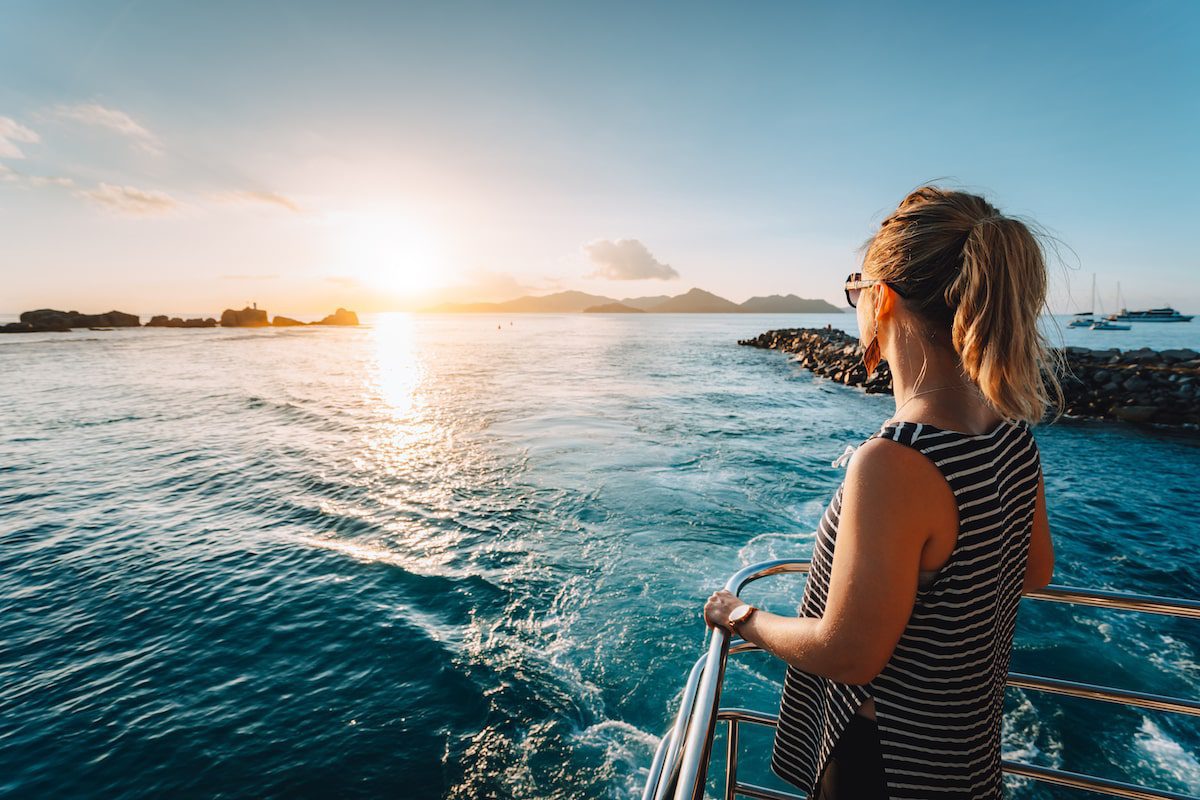Last updated on April 21st, 2024
Featured image: Enjoy the journey without motion sickness | Photo by Igor_Tichonow on Envato
Ways to stop motion sickness and embrace new adventures
by Sandra Phillips
Because motion sickness hits you right in the gut, you might think the disorder originates in the stomach, but you would be wrong. Motion sickness is caused by excess stimulation of the inner ear, inhibiting the body’s ability to maintain its sense of equilibrium. When the vestibular system of the ear receives abnormal motional input – unusual turbulence or an aerobatic maneuver – it causes the stomach’s peristaltic activity to increase, causing motion sickness. Stress and anxiety can feed into this as well.
Throughout history, sailors and others tried various home remedies to block the horrible effects. For some women — any travel — automobile, plane, train, or ship —can bring on motion sickness and can be a deterrent for travel. Since suffering from motion sickness since I was a kid, I tried all the different “cures”, especially when travel media became my career.
There are, of course, a few choices of motion sickness aids on the market: Ginger Root, Dramamine, Gravol or Bonine, Scopolamine Patch, Sea-bands and The Relief Band. I heard about the Relief Band over 20 years ago and have been an ecstatic user since its beginnings. I’ve worn many iterations of the device, and it just keeps getting better. After traveling to 65 countries, all 50 US States and all the Canadian Provinces, I will not leave home without it.
Motion Sickness: Cause and Historical Cures
The word “nausea” comes from Greek “naus” meaning ship, because even that far back, going to sea and getting seasick was regarded as one of the great curses of early navies and merchant fleets. The Roman orator Cicero once said “I would rather be killed than again suffer the tortures of nausea maris”.
Logically, sailors would try whatever was at hand to block out the effects, and that inevitably led to wine or spirits as a tonic to settle the stomach. In the early 12th century, medical monks in Salerno, Italy recommended wine mixed with sea water as a curative for seasickness. Wine in combination with many additives was used throughout the Middle Ages, with the English preferring wine and sage-water and the French, of course, leaning towards their favourite, wine with absinthe.
By the 19th century, scientists and doctors had different theories on its origins. One was that the stomach lining became irritated by the motion of the contents in the stomach. A second professed that motion decreased the blood supply to the brain, causing cerebral anemia, which then caused nausea. The third school of thought was that the inner ear was the key. This proved to be the right answer when it was proven correct by experiments with patients whose inner ears were damaged by scarlet fever. These test subjects would not become seasick even under the worst conditions.
Read More: 16 Wellness Products to Travel with in 2023
Favored drugs included amyl nitrate, used by the cerebral anemia followers, and other practitioners mixed chloroform and potassium bromide to use as a gastric sedative. The experiments went on with: cocaine, opium, strychnine and even cayenne pepper. Then there were the traditionalists who felt that to calm the digestive system, just eating dry toast and gruel with tea or brandy would do.
By the twentieth century, two classes of drugs were used: belladonna alkaloids and sedatives such as barbiturates. Although most effective, they caused many side effects. American troops were given hyoscine (a belladonna derivative) during the D-day crossing, and so many found themselves in a drugged stupor with constricted throats and dilated pupils that they threw the tablets overboard.
How to prevent motion sickness
Those of you who have felt the effects of motion sickness, with the cold sweating followed by extreme nausea and vomiting, know you would do anything not to live through those symptoms again.
There are steps you can take to prepare and prevent this:
1. Don’t travel (air, plane, boat, car) either on an empty stomach or after a heavy greasy meal
2. Face the direction you are traveling and try not to look out of the side windows
3. Breathe fresh air if you can
4. Keep your eyes on the horizon
5. Don’t read while moving

Avoid motion sickness on the road with these remedies
Five cures for motion sickness
1. Ginger root: Ginger root is a traditional herbal remedy that has been known for centuries. It is believed to reduce nausea and vomiting and the stomach cramps that go along with it. Before traveling, you should take ginger root at least an hour before you leave in order to settle your stomach. Nowadays, ginger root can be obtained in health food stores in capsule form which you can either drink with water or break the capsule into a cup of hot water and drink as tea. You could also chew on ginger candy. On board, if you’re feeling a bit queasy, ask for ginger ale to drink, which does help somewhat.
2. Gravol: Dimenhydrinate, more commonly known as Dramamine or Gravol, was the world’s first motion sickness pill. It was discovered quite accidentally. In 1937, a young pregnant lady showed up at Johns Hopkins Hospital in Baltimore with a case of the hives. She kept putting off the trip to go there because the trolley ride made her sick. A new antihistamine drug was given to her, and it cured her hives and quite unexpectedly also relieved her motion sickness problem on the trolley ride back home.
The drug was tested on a large scale in 1948 on soldiers who were being transported to Germany across the Atlantic. A control group was used, and unfortunately for them the rough winter conditions of the Atlantic caused most of them to spend time retching, but 97% of the others who were using the antihistamine had complete relief during the voyage. The first generation of the drug caused much drowsiness, and this side effect was actually used to sell it as a sleeping pill. Meclizine, sold under the brand name Bonine, among others, is another antihistamine which is supposed to cause less sleepiness.
3. Scopolamine patch: The scopolamine patch is usually put behind an ear. They can last up to 3 days. Studies suggest that scopolamine patches work just as well as dimenhydrinate. Also, they may work better than meclizine. However, there are side effects to be aware of.
4. Sea-bands: Sea-bands are knitted elasticized wrist bands that have been clinically tested to help with motion sickness. They are worn on both wrists with a button positioned on an acupuncture spot which is located between your two central tendons on the underside of your wrist. They have been used for years by travelers, yachtsmen, pilots and in hospitals.
5. Relief Band: We also have a techie answer. The Relief Band is a portable Transcutaneous Electrical Nerve Stimulation (TENS) unit that sends low-level electrical impulses to the median nerve center on the underside of the wrist through a pair of lithium batteries and gold-plated electrodes. This pressure point (referred to as the Neiguan Point or P6) is to acupuncture and acupressure practitioners an important link to the digestive system. It is believed that the stimulation of P6 either blocks feelings of pain and nausea from reaching the brain or it may be a stimulus of endorphins, which block the nausea, or it may just interfere with normal stomach rhythms. Get one here.
The Relief Band is a medical device which has received FDA regulatory clearance in the U.S. for relief of nausea and vomiting due to motion sickness. It has been approved for use other than motion sickness, in hospitals and doctors’ offices for more severe nausea and vomiting conditions, including morning sickness and chemotherapy side effects. It is being tested for treatment of pre- and post-operative pain, musculoskeletal problems, labor and delivery, dental pain, fracture pain, pediatric pain, etc.
It too, like the sea-bands, is worn on the wrist and looks like a wristwatch, but the face of it is worn on the reverse side of the wrist. The unit allows the wearer to control the intensity, frequency and amplitude of the electrical impulses to suit the discomfort levels. Symptoms are controlled within minutes of being placed on the underside of wrists, and its calming effects last as long as the device is active. It can even reverse symptoms after the onset of motion sickness.
Of course, motion sickness has been studied in relation to space travel. The lack of gravity throws off the inner ear, as do the unnatural movements performed in outer space, where a space traveler tends to move his whole body instead of rotating just his head. Doug Watt, who was a director of McGill’s Aerospace Medical Research Unit, studied this for over 20 years and presented findings from the Columbia shuttle mission at the Canadian Space Agency. Canadian astronaut Bob Thirsk (and four others) trained to use The Torso Rotation Experiment in order to help learn how to solve this problem. It involved a miner’s type of hat which was wired to keep track of eye, head and torso movements. Astronauts now receive preflight training to avoid certain movements so that they can avoid battling queasiness. Lessons from these experiments help shed light for the rest of us on motion sickness in boats, cars, planes, buses, amusement park rides and even pregnancy.
Whatever your travel plans, don’t let motion sickness deter you!
Read More on Staying Healthy on the Road
When Something Goes Wrong: What to Do if You’re Injured While Travelling
Anything can happen on a vacation. Here are some first-hand tips for women to plan for an unexpected injury.
Alcohol-Free Travel: A Different (and Healthier) Kind of Journey
With the growth of de-alcoholized beers, mocktails and sparkling wine, there’s never been a better to time to try alcohol-free travel.
Menopause Travel Packing List for Women Over 50
Our needs change during menopause; these women-recommended products will help women stay cool and comfortable during travel.







0 Comments
We always strive to use real photos from our own adventures, provided by the guest writer or from our personal travels. However, in some cases, due to photo quality, we must use stock photography. If you have any questions about the photography please let us know.
Disclaimer: We are so happy that you are checking out this page right now! We only recommend things that are suggested by our community, or through our own experience, that we believe will be helpful and practical for you. Some of our pages contain links, which means we’re part of an affiliate program for the product being mentioned. Should you decide to purchase a product using a link from on our site, JourneyWoman may earn a small commission from the retailer, which helps us maintain our beautiful website. JourneyWoman is an Amazon Associate and earns from qualifying purchases. Thank you!
We want to hear what you think about this article, and we welcome any updates or changes to improve it. You can comment below, or send an email to us at [email protected].